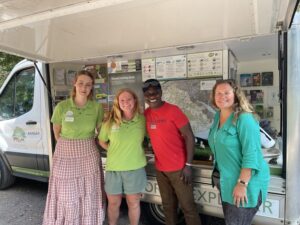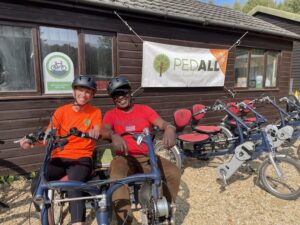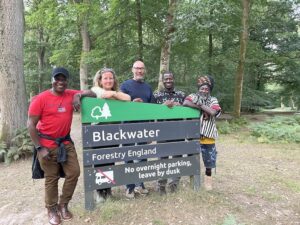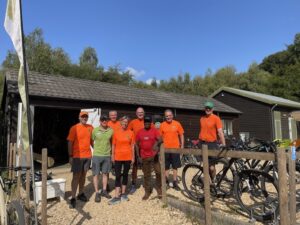Our CEO, Dr Maxwell Ayamba BEM, was invited for a two-day official working visit to the New Forest National Park (NFNP), Brockenhurst, Hampshire, by Alison Barnes, the park’s CEO. Maxwell said it was his first time to visit, and found the NFNP the most culturally diverse of landscapes.
The landscape is quite unique in terms of its history of the Commoners and free-roaming animals and biodiversity. Its uniqueness is in recognition of being a living remnant of medieval England, and at its heart, a commoning system that has shaped the landscape with its historic, cultural and archaeological heritage that most people from minoritised communities in England are not aware of.

The Commoners are ordinary people with an extraordinary commitment to the landscape and culture. The New Forest Pony Breeding and Cattle Society holds annual shows in August during the Bank holiday every year, a spectacular event to watch.
The NFNP was designated on March 1st 2005 as the first English National Park to be created in the 21st Century.

Maxwell said he was taken on tour by the CEO Alison Barnes and Jim Mitchell an experienced Ranger. He was introduced to the exceptional diversity and inclusion community engagement work taking place in collaboration with community partners such as PEDALL an inclusive cycling initiative that provides cycles suitable for many people who face challenges accessing cycling in the New Forest such as people with profound disabilities from residential homes. The New Forest Voices project, a “The Commoning Voices Story“, is an example of how together subaltern voices have been raised with bold steps taken for everyone to tell their own stories about the landscape. The NFNP Nightjar project, an example of a collaborative project with West African artists from Ghana, who work with schools and community groups exploring migration, transient and dualities of England and West Africa – two different landscapes with a shared history of the Nightjar. Maxwell said he was taken on a night walk accompanied by the CEO of NFNP and Jim Mitchell, Ranger NFNP and two Ghanaian Artists and an African-Caribbean to listen to the soundtrack of the Nightjar which is quite a nocturnal bird that migrates to the forest from West Africa. This demonstrates the cultural heritage shared between two different landscapes – UK and West Africa symbolised by the Nightjar.

Maxwell said he was also taken to meet Spud Works, an arts project working with the NFNP and communities raising awareness of the landscape and its history through the medium of art.
Maxwell said he also met with a representative from the NFNP Youth Board, Hayley Quarinnington who work with community groups by undertaking surveys to gain people’s opinion on nature connection and views about the New Forest. Providing residential weekends through the Cameron Bespolka Trust which works with young people to connect them to nature, called the “Youth for Nature project”. But above all, the Youth Board has a holistic approach to governance of the NFNP, influencing and shaping ideas, challenging power and decision-making. Maxwell also met Hayden Bridgeman – a wonderful Youth Ranger, who undertakes Community Outreach work with refugees and asylum seekers and whose work won a Europac scholarship for her refuge work at the New Forest for championing the project. Hayden added that, EUROPARC is committed to actively seeking to amplify youth voices in its work providing space for young people to champion their voices by making youth voices prominent.

Maxwell said he found the visit very rewarding as the NFNP was indeed leading the way by showing a proactive and inclusive cultural practice which only not recognises but values people’s differences, acknowledging that diversity is about recognising differences. NFNP further acknowledges the benefits of having a range perspectives in decision making and that inclusion is about where people’s differences are valued and used to enable everyone to thrive. Maxwell said he thanks Alison Barnes CEO NFNP and Jim Mitchell and rest of the team for making the visit possible. He noted that there is a lot to discover, learn, and share to make our National Parks inclusive spaces for everyone through our shared heritage.